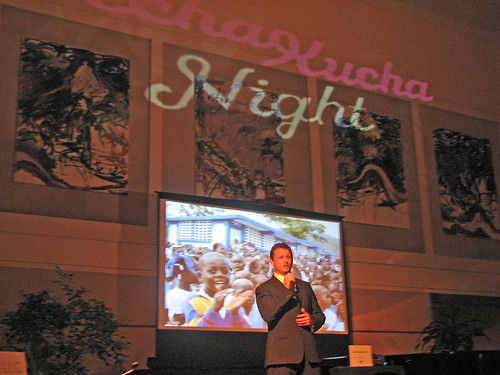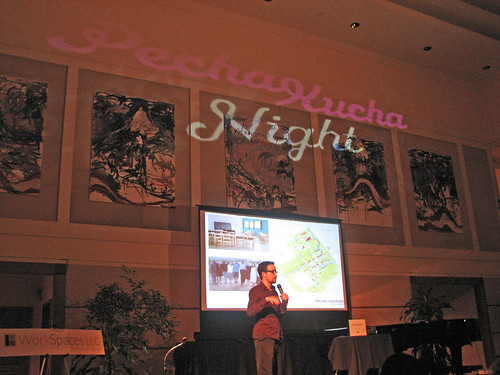
‘Reception – PechaKucha Vol.11’
courtesy of ‘prettylovelythings’
Capitol PechaKucha Night Vol. 11 was held Friday night at the Embassy of Austria as a unique means to provide global awareness about the earthquake that shattered Haiti. In addition to the Nation’s Capital, on February 20th, 280 other cities across the world held PechaKucha’s in collaboration with Architecture for Humanity to help rebuild Haiti 20 seconds at a time.
The PechaKucha originally began in Tokyo circa 2003 and was developed by Astrid Klein and Mark Dytham of Klein Dytham Architecture as a way to get young designers sharing ideas under one roof. PechaKucha is translated from the Japanese term for “chit chat” and refers to the type of presentation format that is utilized for the now globally celebrated event. Each presenter at a PechaKucha displays 20 images, each lasting for 20 seconds, while talking alongside their slideshow – a format that supports a presentation that keeps things interesting for both the presenter and their audience.
PechaKucha Vol. 11 was quite the success. The grand hall of the Embassy of Austria served as the perfect backdrop for the hip and influential crowd that quickly filled the entire room. During the reception hour, event attendees were able to drink, snack, and socialize while taking in the Embassy’s ongoing cultural exhibits located along the perimeter space – all while listening to music via the likes of DJ Watson. The crowd was quite atypical for what is commonly expected of the DC scene, creating a type of diversity that was welcomed for this unique event.

‘Skyler Badenoch – PechaKucha Vol.11’
courtesy of ‘prettylovelythings’
Following open remarks given by Austrian Ambassador Christian Prosl to a full house, the presenters quickly filled the stage. Speakers were encouraged to discuss their experiences and ideas relevant to the issues facing Haiti, and the chosen seven for this evening each had their very own version of the story to share. The night started off with a presentation by Lola Poisson-Joseph, Wife of The Ambassador of Haiti, who spoke about her humanitarian efforts as Founder of the Children & Families Global Development. Sharing photographs of century old churches and elementary schools that no longer stand in the aftermath of the quake, Poisson-Joseph’s presentation was heartfelt and moving.
Next up was Josef Fuentes on behalf of Architecture for Humanity’s DC Chapter. Fuentes stressed from the very first slide the power of design and community participation during the repair of a country following a natural disaster. Fuentes expressed Architecture for Humanity’s goal to focus on long-term rebuilding and short-term solutions, such as through the creation of satellite centers that will both “anchor the community” and “fill the gaps” during repair.
One of the most powerful speakers of the evening was Skyler Badenoch of buildOn. Badenoch was part of a first response team that entered Haiti the day following the disaster. Badenoch shared personal photographs while reading from the journal he kept during his weeks in the torn country. “Every second was the most important second” Badenoch said, his small team was “surviving as an effective lifeboat – a very small lifeboat in a sea of disaster”. Moreover, Badenoch – and most of his counterparts that evening – expressed that through all of the adversity facing the Haitian community, the children remain the most resilient. That the children, laughing and playing, represent the hopeful “sounds of the future”.

‘Josef Fuentes – PechaKucha Vol.11’
courtesy of ‘prettylovelythings’
Aaaron Banks with the ONE campaign discussed, in a more formal manor, the need to eliminate Haiti’s international debt so that the country can focus entirely on rebuild and repair. Banks firmly stressed that debt cancellation is “not a silver bullet” and that much more assistance will be needed for long-term recovery in Haiti. Following Banks, Karina Gomes – a producer for Al Jazeera English – shared a journalist’s perspective following a natural disaster. Although somewhat surprising to hear, Gomes explained that “the bigger the event the more exciting it is because journalism runs on adrenaline”, and later shared what is more commonly accepted of the role – that the goal of the journalist following disaster is to engage, “to talk to the people and share their stories”.
Rounding out the evening was Mikael Moore, photographer and Chief of Staff for Congresswoman Maxine Waters (D-CA), and on behalf of Clowns Without Borders USA, Bruce Macphail. Both Moore and Waters provided different, yet equally impressive, perspectives on the disaster in Haiti, one through the lens of his camera and the other through the eyes of a child.
The verdict is still out on whether or not The Global PechaKucha Night for Haiti raised or exceeded its goal of $1,000,000 for rebuilding the country, but one thing is for sure – the collaborative effort shared from continent to continent this weekend was truly inspirational for all those involved.
Damn. Aaron from ONE ran off very quickly (or at least, I didn’t find him after the event got over) and I couldn’t ask him about what his experience has been with debt relief. A number of countries whose debt was wiped clean by the HIPC Initiative were soon back in debt, at higher rates, to the Chinese government – so I wonder if they’ve worked on coming up with a longer term strategy to prevent Haiti from ending up back in debt.
PS – the red wine was really awful.